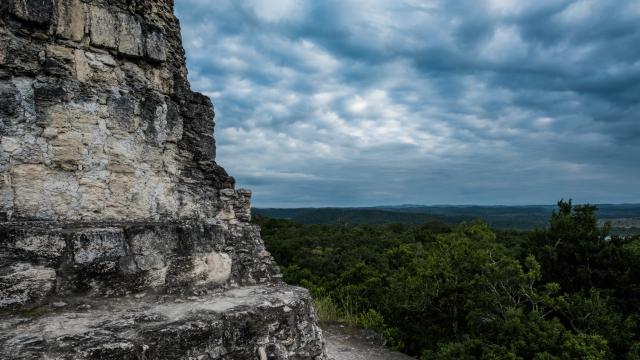More than 3,000 years ago, the ancient Maya spread across the Yucatán Peninsula and neighbouring areas, clearing rainforest for agriculture and cities as they went. Though their civilisation mysteriously collapsed around the ninth century, it left an indelible mark on the region’s tropical rainforests, one that presents a warning to people clear-cutting the tropics today.
Research far more extensive damage to Earth’s rainforests than the Maya did 3,000 years ago.
“What I think these data give us is a much longer-term perspective,” Peter Douglas, a geochemist at McGill University and lead author on the study, told Earther. “What they tell us is at least in this place…we seem to be losing a lot of this deep carbon over hundreds of years.”
Tropical rainforests are like carbon dioxide sponges, their plants sucking down tremendous amounts of the greenhouse gas for photosynthesis. When those plants die, that carbon makes its way into the soil, where some of it gets stuck to minerals and locked away for hundreds to thousands of years. Scientists estimate there are nearly 500 billion tons of carbon stored in tropical soils, or more than half of what’s currently in our atmosphere.
The new study attempts to shed light on what human activity means for that carbon over the long term. To do so the authors turned to radiocarbon dating, a widely-used technique for determining the precise age of centuries to millennia-old organic remains. Specifically, they looked at the age of hard-to-decompose plant waxes in sediment cores taken from three lakes in the former Maya lowlands. The idea is that the waxes make their way into lakes only after becoming buried in nearby forest soils and that their age offers an indicator of how long carbon sticks around in the ground.
The findings were dramatic. The study found a 70-90 per cent decrease in the age of plant waxes leaking out of soils over the past 3,500 years, a decline that closely matched patterns of deforestation resulting from Mayan expansion. While there’s some indication that soil carbon began sticking around longer after Spanish conquest depopulated the region 500 years ago, the carbon sink never recovered to where it was before human settlement.
“This implies that Maya land use strongly reduced the ability of regional soils to act as long-term carbon sinks,” the authors write in the study.
The researchers can’t say exactly why that is, nor can they say every tropical forest will respond the same way to deforestation. But the findings do suggest that the logging of old-growth rainforests may have lasting impacts even if the forests are allowed to recover.
“We are counting on reforestation as a critical climate change mitigation action in near future,” Susan Crow, a soil ecologist at the University of Hawaiʻi at Mānoa who wasn’t involved with the new paper told Earther via email. “[T]his paper seems to question the effectiveness of this strategy.”
While Crow thought the paper’s methods showed “great potential to reveal how carbon moves around on complex landscapes,” she pointed out that Mayan soils could still be rebuilding their carbon stocks, even if that carbon is cycling between soils and the atmosphere faster than it was before humans arrived.
“Let us hope that the next phase of reduced land use intensity happens not by conquest or collapse of civilisation, but by a more enlightened path of collective change,” she said.
